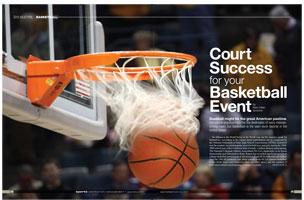
Baseball might be the great American pastime, and soccer practice might be the destination of every minivan-driving mom, but basketball is the slam-dunk favorite in the United States.
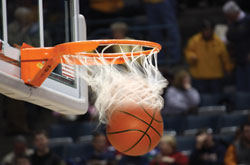 No offense to the World Series or the World Cup, but the statistics speak for themselves. According to the annual sports participation survey conducted by the National Federation of State High School Associations (NFHS), basketball was the number one most popular sport for both boys and girls during the 2008-2009 school year with a combined total of nearly 1 million students participating. The National Collegiate Athletic Association (NCAA), meanwhile, in its Sports Sponsorship and Participation Rates Report has recorded significant growth in college basketball participation in Divisions I, II and III for both men and women since the 1981-82 academic year. More schools in the NCAA sponsor basketball teams (both men's and women's) than any other sport, and the number of individual athletes participating continues to climb.
No offense to the World Series or the World Cup, but the statistics speak for themselves. According to the annual sports participation survey conducted by the National Federation of State High School Associations (NFHS), basketball was the number one most popular sport for both boys and girls during the 2008-2009 school year with a combined total of nearly 1 million students participating. The National Collegiate Athletic Association (NCAA), meanwhile, in its Sports Sponsorship and Participation Rates Report has recorded significant growth in college basketball participation in Divisions I, II and III for both men and women since the 1981-82 academic year. More schools in the NCAA sponsor basketball teams (both men's and women's) than any other sport, and the number of individual athletes participating continues to climb.
And that's only what can be tracked mathematically. Drop by any park, rec center or health club and you'll find basketball being played in leagues, teams and pick-up games. Drive through a neighborhood and you'll see kids shooting baskets into the ubiquitous hoop over the garage door. Turn on ESPN and you can see NBA and WNBA play, and hey - the NCAA tournament is called March Madness for a reason.
And now it's your turn. Maybe you're helping to plan a regional tournament. Maybe it's a skill clinic or a camp. No matter who's coming, no matter who's competing, you're the one who is hoping to score. But where to start? And how?
At the beginning, say the professionals. Consider this the tip-off in finding the perfect facility.
Order in the Court
At first glance, basketball might not appear to have anything in common with baseball. It does, though: The size of the playing area can vary, depending upon the age of the players. A high school-age team, for example, does not play on a court the same size as an NBA team.
According to the website of the National Basketball Association, in NBA and WNBA play (the professional leagues for adult men and adult women), a basketball court is 94 feet long and 50 feet wide. In high school and college play, the court is 84 feet long and 50 feet wide. For junior high play, the length of the court is 74 feet and the width is 50 feet. According to the website of the National Wheelchair Basketball Association, a court for the game of wheelchair basketball should be 84 feet long and 50 feet wide. Despite the variance in size, however, many of the markings on the interior of the court remain the same.
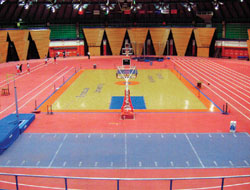 Because rules set forth by the various governing bodies can change periodically, make sure the facility you are considering is in compliance with the most recent version of the rules. Of course, while correct court dimensions are important in sanctioned competitions, they may be less so for an event like a skills camp.
Because rules set forth by the various governing bodies can change periodically, make sure the facility you are considering is in compliance with the most recent version of the rules. Of course, while correct court dimensions are important in sanctioned competitions, they may be less so for an event like a skills camp.
Indoors or Out?
The choice of an indoor or outdoor venue will depend upon many considerations, including the scope of your event, the time of day play will take place, the weather, your budget, the estimated attendance and more. For example, if the event is for students, and must be played within a certain window of time (such as during a school break or on a weekend), using an outdoor venue may be risky without having an emergency backup facility in case of inclement weather.
One of the great advantages to indoor facilities is not just the lack of weather worries, but the presence of the great amenities that give the event such a boost: lighting and HVAC systems, rest rooms and more. Many colleges and high schools, as well as indoor wellness centers, offer rentals. However, there are many high-quality outdoor facilities as well.
On the Surface
An outdoor court will most likely be asphalt or concrete covered with an acrylic coating, although other options exist. An indoor court will generally have a wood floor or a synthetic sports surface. In all cases, playing lines should be marked clearly and the court surface should be free of any imperfections that could impede play or cause injury to players.
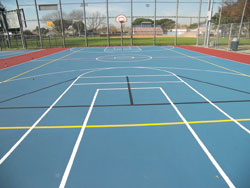 According to Art Tucker of California Products Corp. Plexipave Division in Andover, Massachusetts, those who are planning an outdoor event should check court surfaces for possible hazards.
According to Art Tucker of California Products Corp. Plexipave Division in Andover, Massachusetts, those who are planning an outdoor event should check court surfaces for possible hazards.
"Carefully consider the texture (of the surface)," says Tucker. "Basketball can be played in damp conditions more readily than tennis. It may be wise to select a court with a coarser texture. Smoother surfaces should be carefully evaluated."
Some sports facilities have regulations concerning the type of shoe that can be worn in order to keep from marking the surface.
Up Above
An indoor facility, as mentioned, will certainly have lighting. In an outdoor facility, court lighting can allow for night play, so that one court can host more games. In addition, it can accommodate games that go into overtime, or which might have been rescheduled due to inclement weather.
Indoors or out, different levels of play require different levels of light. Light levels increase with the level of competition, so that major championship events and games where play will be televised will need the most light. Guidelines are available through governing bodies.
Game Equipment
In addition to the size of the playing area, the goal must meet the standards of the governing body. In all levels of play, the rim of the basket must be exactly 10 feet from the floor. The net and backboard maybe permanently affixed on a pole, or it may be retractable, allowing the equipment to be raised and lowered into place.
On the Sidelines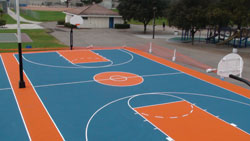 In basketball, space will be needed on the sidelines for officials, coaches, team personnel, cheerleaders and more. Make sure there is adequate clearance so that everyone stays safe. The governing body might specify a safe overrun area for players.
In basketball, space will be needed on the sidelines for officials, coaches, team personnel, cheerleaders and more. Make sure there is adequate clearance so that everyone stays safe. The governing body might specify a safe overrun area for players.
On the Fence
Fencing around outdoor courts keeps unwanted foot traffic off the playing area, keeps balls in play and defines the boundaries to players. Fencing may go all around or be placed only behind baskets.
Officials
Game officials should be well versed in the rules for the league, governing body and age group for the specific event. The local high school athletic association, sports officials association, etc. can help point you in the correct direction. For an event being held during a busy season, officials’ time may need to be reserved in advance.
Ask for advice
Local athletic associations have information regarding the various sports facilities in the area. Just as importantly, they may have insights on state-specific rules concerning athlete participation.
Other Considerations
Define your needs: If you are planning to have multiple teams present, with multiple games, contests or practices going on simultaneously, you’ll need multiple courts. If you are hosting a competitive event with an elimination format, the number of courts needed will get smaller with time.
Parking is critical: Whether your players arrive in a team bus or whether they come by carpool, you’ll need parking. Spectators, officials and team supporters (and depending upon the level of play, scouts appearing on behalf of schools or teams) will all want to be close to the facility.
Equipment needs: Bags, shoes, uniforms, balls - basketball isn't an equipment-heavy sport, but property does need to be stored safely and conveniently. Should games be held outside, and should there be a possibility of rain, the storage location should be weatherproof.
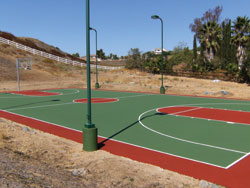 Seating: If this is a competitive event, and if it is not being held in a facility with bleachers, seating will need to be provided for spectators, team members, etc. ADA considerations should always be taken into account; however, if your event will include wheelchair-bound players, the facility will need to accommodate more individuals (players and spectators) with varying levels of mobility.
Seating: If this is a competitive event, and if it is not being held in a facility with bleachers, seating will need to be provided for spectators, team members, etc. ADA considerations should always be taken into account; however, if your event will include wheelchair-bound players, the facility will need to accommodate more individuals (players and spectators) with varying levels of mobility.
Conveniences: On-site rest rooms (or, if you're outside, portable toilets and hand sanitizing stations) are necessary. Refreshment stands are nice additions. Booths for souvenir sales allow teams to fund raise.
Amenities: Depending upon the level of play and the nature of your event, look for various amenities, such as a public address system, score board and play clock.
Emergency Facilities: The facility may have a first-aid tent or office, and also must be accessible to emergency personnel.
Media-Friendly: Want newspaper, radio and/or TV coverage? Look for a facility with a working press box.
What's Fun?
Look for attractions that players and others can take advantage of during downtime. For example, of interest to youth might be areas with restaurants, malls and tourist attractions like mini-golf, theme parks, etc.
Court success with your basketball event by doing all the necessary research. You'll shoot and score every time.

